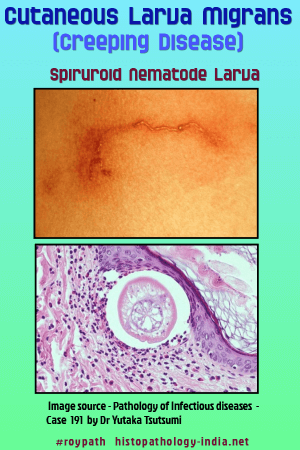|

Custom Search
|
|
Infectious Disease Online Pathology of Cutaneous Larva Migrans
|

Cutaneous larva migrans is caused by migration of larval nematodes through the epidermis.The migrating worms provoke severe inflammation, which appears as serpinginous urticarial trails. The names applied to this condition are as varied as the organisms that cause it and include creeping eruptions, sandworm, plumberís itch, duck hunterís itch, and epidermis linearis migrans. The common larval nematodes are Strongyloides stercoralis, Ancylostoma brasiliensis , Ancylostoma caninum, Uncinaria stenocephala, Bunostomum phlebotomum, Necator americanus and Gnathostoma spinigerum. In a condition known as larva currens (creeping eruption), the agent is Strongyloides stercoralis. This disorder was first reported in prisoners of war held by the Japanese during Word War II. Unlike cutaneous larva migrans, linear urticarial trails in the area of the anus are the only lesions. Dogs and cats infected with hookworm are the major source of the disease. Outbreaks of cutaneous larva migrans occur at subtropical and tropical beaches. Plumbers who crawl under houses and animal caretakers are also frequently infected. The diagnosis is based on history and clinical appearance.
|
|
|
Copyright © 2022 histopathology-india.net

